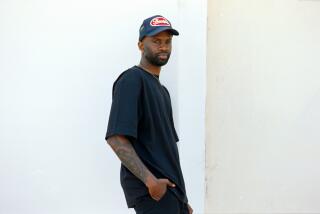ART REVIEW : ‘Decades’ Celebrates English Photo History
- Share via
“The Formative Decades: Photography in Great Britain, 1839-1920,” at the County Museum of Art, kicks off a spate of exhibitions celebrating the 150th birthday of photography.
Before the year is over, every photo show in the country will probably be billed as a commemorative event, but this one really digs into history.
Containing 130 images from the riches of the Harry Ransom Humanities Research Center at the University of Texas at Austin, “The Formative Decades” was actually organized for the university’s centennial, but it serves very well as a toast to the medium. From early images of leaves produced without a camera and jewel-like daguerreotype portraits in velvet-lined cases to 1919 X-rays of incubating eggs, the exhibition is a captivating journey through photography’s early, experimental days.
The English penchant for travel--typified by the Grand Tour--is reflected in many images but it also serves as a metaphor for the entire exhibition. English photographers actually lugged glass plates and cumbersome cameras to the Egyptian pyramids and took more up-to-date equipment to the Antarctic, as we see in works by Francis Frith and Herbert George Ponting.
But even when they stayed at home, the photographers in the exhibition often behaved as intrepid explorers in unknown terrain, trying every facet of the new medium and every possible application of this democratic art form. Whatever else they may be, these pictures are a record of a struggle against technical and material limitations.
Many of the images in the show don’t look like art; instead, they reflect a period when inventive people were trying to figure out what to do with photography and how to stretch its capabilities.
The results are sometimes bizarre. An example of “spirit photography,” for example, depicts a draped female head emerging from another head. Though obviously manipulated, this image was collected by Sir Arthur Conan Doyle as “evidence” of spiritualism. Other pictures occasionally border on the ghoulish: portraits of a dead baby, a starving Russian girl and a Zulu prince who was about to expire.
More often, the photographs are elaborately posed theatrical compositions or relatively straightforward landscapes that tell us a great deal about British values and life styles.
Among the most telling are “living” tableaux of costumed characters that provided entertaining morality lessons for Victorian and Edwardian citizens. Julia Margaret Cameron, represented here by a couple of romantic portraits, was the premiere artist of the genre. But we also find Henry Peach Robinson going to enormous trouble to combine negatives and studio setups in “When Day’s Work is Done,” a sentimental picture of an elderly couple.
The firm of Hughes and Mullins photographed members of the royal family acting out “Idylls of the King,” while T. A. Rust posed a devil and an angel in a wacky scene called “The Game of Life.” Another curiosity is a hand-colored stereograph by Alfred Silvester that features peasants beating up on a goose dressed as Emperor Louis-Napoleon.
Like writers and painters, these Pictorialists were looking for important themes. Today, most of their pictures appear to be illustration, though it simulates painting and bears some relationship to current “fabricated-to-be-photographed” work.
“Straight” photography and street work didn’t come into vogue until the mid-20th Century, but their counterparts and predecessors are here. Peter Henry Emerson, who advocated a “naturalistic” approach, is represented by a surprisingly economical image of farmers in a hay field. Horatio Nelson King’s picture of Hampton Court (circa 1880) is strikingly modern in its emphasis on the structure and shadows of a bridge.
Other photographs of humble workmen, dramatic waterfalls, rock formations and tropical plants document the growth of photography as an amateur sport.
Some portraits reveal an urge to show people as working members of a community rather than picture-perfect subjects. Joseph Parkin Mayall’s portrait of artist Valentine Cameron Prinsep in his studio and W. Currey’s shot of Prime Minister William Gladstone resting after chopping wood are certainly not candid, but they mark an abrupt departure from the properly stiff, staged images that predominate.
“The Formative Decade” (to March 19) is a show of details, an exhibition that has us peering closely at tiny images or intricate bits of larger ones and sets us to questioning the limitations of dozens of techniques. In fact, it’s so intriguing that we hardly notice how weak it is as an art show. This seems to reflect a conscious curatorial decision, however. The point is to demonstrate how photography grew up in England and how firmly it was woven into middle-class life.
One of the least compelling images illustrates this idea with resounding clarity. It’s an unidentified photographer’s picture of a house in India. Out of focus and produced on a broken plate, it was nonetheless preserved in an English gentleman’s album. More than any other image in the show, this one speaks of photography’s ability to create a surrogate experience, to conjure up a memory that must be preserved.
More to Read
The biggest entertainment stories
Get our big stories about Hollywood, film, television, music, arts, culture and more right in your inbox as soon as they publish.
You may occasionally receive promotional content from the Los Angeles Times.










